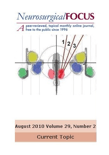
Neurosurgical Focus
Scope & Guideline
Shaping the Future of Neurological Surgery
Introduction
Aims and Scopes
- Focused Ultrasound Applications:
The journal extensively covers the use of focused ultrasound in various neurosurgical applications, including treatment for movement disorders, psychiatric conditions, and pediatric neurosurgery. This reflects a commitment to exploring non-invasive and minimally invasive therapeutic options. - Neuro-oncology:
Research articles often focus on the management of brain tumors, including surgical techniques, adjuvant therapies, and novel treatment approaches such as immunotherapy and gene therapy. This area highlights the journal's dedication to advancing the understanding and treatment of complex neurological malignancies. - Transitional Neurosurgery:
A significant emphasis is placed on the transition of care from pediatric to adult neurosurgical practices, particularly for conditions such as spina bifida and Chiari malformation. This focus underscores the importance of continuity in care and tailored treatment strategies for diverse patient populations. - Technological Innovations:
The journal frequently explores the integration of advanced technologies in neurosurgery, such as augmented reality, machine learning, and robotic surgery. This reflects an ongoing commitment to enhancing surgical precision and improving patient outcomes. - Healthcare Disparities and Inclusion:
Recent publications indicate a growing focus on understanding and addressing disparities in neurosurgical care, particularly related to gender, race, and socioeconomic status. This aim highlights the journal's commitment to fostering diversity and equity within the neurosurgical community.
Trending and Emerging
- Enhanced Recovery After Surgery (ERAS) Protocols:
There is a growing interest in the implementation of ERAS protocols within neurosurgery, focusing on optimizing patient outcomes, minimizing complications, and enhancing recovery times post-surgery. - Artificial Intelligence and Machine Learning Applications:
The integration of AI and machine learning in neurosurgery is rapidly gaining momentum, with research exploring predictive analytics, surgical planning, and patient outcome optimization. This trend highlights the potential for technology to revolutionize neurosurgical practices. - Neurosurgery for Psychiatric Disorders:
An increasing body of work is dedicated to exploring neurosurgical interventions for psychiatric conditions, including focused ultrasound and deep brain stimulation. This emerging area signifies a cross-disciplinary approach to treating complex mental health issues. - Telemedicine and Remote Care Models:
The COVID-19 pandemic has accelerated the adoption of telemedicine in neurosurgery, with ongoing research evaluating its effectiveness and feasibility in patient management and follow-up care. - Patient-Centric Approaches in Neurosurgery:
There is an emerging trend towards incorporating patient-reported outcomes and quality of life measures in neurosurgical research, emphasizing the importance of patient experience and satisfaction in treatment evaluations.
Declining or Waning
- Traditional Surgical Techniques:
There is a noticeable decrease in publications focused on traditional neurosurgical methods, as newer, less invasive techniques gain traction. This trend suggests a move towards embracing innovation and minimizing the reliance on conventional surgical approaches. - Single-Institution Studies:
The prevalence of single-institution studies has diminished, with a trend towards multicenter collaborations and larger cohort analyses. This shift indicates a growing emphasis on broader applicability and generalizability of research findings. - Historical Perspectives in Neurosurgery:
Research focusing on the historical aspects of neurosurgery, while still relevant, has seen a decline in frequency. This suggests a potential shift in interest towards contemporary issues and advancements rather than retrospective analyses. - Basic Neuroscience Research:
There appears to be a waning focus on fundamental neuroscience research within the context of clinical neurosurgery. This shift may indicate a stronger preference for applied research that directly impacts surgical practice and patient care.
Similar Journals

CHILDS NERVOUS SYSTEM
Connecting Knowledge and Care in Child NeurologyCHILDS NERVOUS SYSTEM is a distinguished academic journal published by SPRINGER, focusing on the vital intersections of pediatrics, neurology, and child health. With an ISSN of 0256-7040 and an E-ISSN of 1433-0350, this journal has been an important platform for research since its inception in 1985 and continues to contribute significantly to the field, as reflected in its impressive quartile standings: Q3 in Medicine (miscellaneous) and Neurology (clinical), and Q2 in Pediatrics, Perinatology, and Child Health for 2023. Despite its Q3 rankings in two categories, it holds a respectable position in Scopus rankings, showcasing its relevance among peers in pediatric and neurological studies. The journal aims to disseminate new research and insights that enhance the understanding of neurological conditions in children, offering a comprehensive view of both clinical practices and advancements in medicine. Though it currently does not provide Open Access options, its rigorous peer-review process ensures high-quality content that is indispensable for researchers, clinicians, and professionals dedicated to improving child health outcomes.

CESKA A SLOVENSKA NEUROLOGIE A NEUROCHIRURGIE
Empowering Professionals with Valuable Clinical InsightsCESKA A SLOVENSKA NEUROLOGIE A NEUROCHIRURGIE is a prominent scientific journal focusing on the fields of neurology and neurosurgery, published by the esteemed Czech Medical Society. Since its inception in 1973, the journal has aimed to disseminate significant research and advancements in clinical neurology and surgery, contributing to the body of knowledge for professionals and researchers in these fields. Operating under a non-open access model, it maintains a dedicated readership interested in valuable insights from the latest studies and clinical practices. The journal is currently classified in the Q4 category in both Neurology (Clinical) and Surgery, reflecting its ongoing efforts to provide a platform for impactful research, despite being ranked in the lower percentiles within Scopus. Based in Prague, Czech Republic, this journal not only serves as a repository of clinical findings but also encourages collaboration and scholarly dialogue among neurologists and neurosurgeons, driving the field towards further innovations in patient care. With coverage extending from 1973 to 2024, it stands as a key resource for those committed to advancing neurological and surgical sciences.
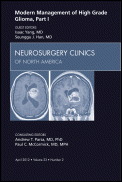
NEUROSURGERY CLINICS OF NORTH AMERICA
Connecting Innovators in Neurosurgery and Neurology.NEUROSURGERY CLINICS OF NORTH AMERICA, published by W B Saunders Co-Elsevier Inc, is a leading interdisciplinary journal that serves as a pivotal resource for neurosurgeons, neurologists, and medical researchers dedicated to advancing the field of neurosurgery. With an impressive impact factor demonstrated by its 2023 quartile rankings—Q2 in Medicine (Miscellaneous) and Neurology (Clinical), and Q1 in Surgery—this journal garners significant attention and respect within the academic community. Spanning from 1990 to 2024, it publishes insightful reviews and clinical studies that address contemporary challenges in neurosurgery, thereby facilitating the exchange of knowledge and innovations among professionals in the field. Although not an open-access journal, its curated content is essential for maintaining high standards of practice and is widely recognized, as evidenced by its Scopus ranks which place it in the top percentiles of both Surgery and Clinical Neurology. By engaging with this journal, readers participate in a rich dialogue that is crucial for shaping the future of neurosurgical practice.

Turkish Neurosurgery
Shaping the Landscape of Neurosurgery Through ResearchTurkish Neurosurgery is a distinguished journal published by the TURKISH NEUROSURGICAL SOC, dedicated to advancing the field of neurosurgery and clinical neurology. With an ISSN of 1019-5149 and converging its focus from 1990 to 2024, this regional journal aims to bridge the gap in knowledge dissemination within Turkey and beyond. It holds a notable position in the academic community, categorized in the Q3 quartile for both Neurology (clinical) and Surgery in 2023, illustrating its relevance in these critical fields. Although currently not an open-access publication, it offers insights and research findings that are vital for researchers, practitioners, and students who seek to stay abreast of developments in neurosurgical practices. Located in Ankara, Turkiye, Turkish Neurosurgery provides a platform for sharing rigorous research that enhances clinical outcomes and informs surgical techniques, thus playing a crucial role in elevating the standards of neurosurgery in the region.

Brain and Spine
Fostering interdisciplinary dialogue for groundbreaking neurological discoveries.Brain and Spine is a premier academic journal published by ELSEVIER, dedicated to advancing the fields of neuroscience and neurology. With its unique focus on the complex interactions between brain function and spinal health, this journal serves as an essential resource for researchers, clinicians, and students alike. Though currently lacking an official impact factor, its ranking within Scopus highlights its relevance, placing it in the 25th percentile for neuroscience (miscellaneous) and the 23rd percentile within neurology, indicating that while it is a developing journal, it holds potential for significant contributions to the field. Operating under open-access principles, it aims to disseminate valuable findings widely, ensuring that novel insights into neurological health are accessible to a global audience. Brain and Spine seeks to foster interdisciplinary collaboration and innovation, making it an invaluable platform for those striving to enhance our understanding of the brain and spinal cord's intricate functions and interdependencies.
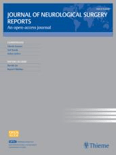
Journal of Neurological Surgery Reports
Transforming research into practice for better patient outcomes.The Journal of Neurological Surgery Reports, published by GEORG THIEME VERLAG KG, serves as a pivotal platform for groundbreaking research in the field of neurological surgery. As an Open Access journal since 2012, it ensures that vital findings are accessible to a global audience, thereby promoting knowledge sharing and collaboration among researchers, clinicians, and students alike. With an ISSN of 2193-6358 and an E-ISSN of 2193-6366, this journal consistently ranks within the 41st percentile in the field of Medicine & Surgery and the 26th percentile in Medicine & Neurology (Clinical) according to Scopus, highlighting its commitment to quality and relevance. The journal's focus encompasses a wide spectrum of topics within neurological surgery, encouraging submissions that advance understanding and treatment of neurological conditions. By fostering a rich scientific discourse, the Journal of Neurological Surgery Reports plays an essential role in shaping the future of neurological healthcare.

Egyptian Journal of Neurosurgery
Unlocking the Mysteries of the Brain and SpineWelcome to the Egyptian Journal of Neurosurgery, a leading publication in the field of neurosurgery, meticulously curated by SPRINGERNATURE. With an E-ISSN of 2520-8225, this journal has been committed to advancing the understanding of neurosurgical practices since embracing Open Access in 2018, ensuring widespread accessibility of groundbreaking research and clinical insights. Based in London, England, at CAMPUS, 4 CRINAN ST, LONDON N1 9XW, the journal aims to bridge gaps in neuroscience research, providing a platform for innovative studies, systematic reviews, and case reports. By publishing high-quality, peer-reviewed articles, the Egyptian Journal of Neurosurgery aims to equip researchers, professionals, and students with the knowledge and tools necessary to enhance patient care and outcomes in neurosurgical practices globally. Join our vibrant community of scholars dedicated to exploring the complexities of the brain and spine, and contribute to the evolving narrative of neurosurgery.
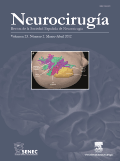
NEUROCIRUGIA
Advancing the frontiers of neurosurgery and neurology.NEUROCIRUGIA, published by ELSEVIER ESPANA SLU, is a prominent journal in the fields of Neurology and Surgery, serving as a critical resource for researchers, clinicians, and students alike. With an ISSN of 1130-1473 and an E-ISSN of 2340-6305, this esteemed publication offers a platform for the dissemination of innovative research findings, clinical practices, and insights into the evolving challenges of neurosurgery. While the journal is currently categorized in the Q3 quartile within both Neurology (clinical) and Surgery disciplines, it continues to enhance its impact through rigorous peer review and a commitment to accessibility, despite not offering open access. NEUROCIRUGIA has a rich historical background, covering converged years from 1972 to 1980, 1990 to 1995, and continuously from 1999 to 2024. With its strong position in the Scopus rankings, being placed in the 41st and 23rd percentiles in the respective categories, the journal not only reflects the current needs within neurological and surgical research but also invites contributions that push the boundaries of knowledge in these critical areas of medicine.
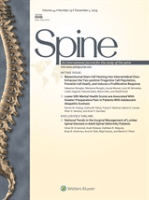
SPINE
Exploring the frontiers of spine health and disease.SPINE, published by Lippincott Williams & Wilkins, is a leading academic journal in the fields of Orthopedics, Neurology, and Sports Medicine. Established in 1976, this reputable journal has made significant contributions to advancing clinical and scientific knowledge, with its impactful research evidenced by its prestigious Q1 classification across three essential categories in 2023 and a notable ranking of #51 in Orthopedics and Sports Medicine and #117 in Clinical Neurology as per Scopus. SPINE aims to disseminate high-quality research articles, reviews, and clinical studies that address cutting-edge topics and challenges in spine-related health, thereby serving as an invaluable resource for researchers, healthcare professionals, and students alike. With its commitment to rigorous peer review and a wide readership, SPINE continues to be at the forefront of innovations in spine health & disease from 1976 to 2024, upholding its reputation as a catalyst for progress in the medical community.

ACTA NEUROCHIRURGICA
Fostering Innovation in Neurology and Surgical Practices.ACTA NEUROCHIRURGICA, published by Springer Wien, stands as a pivotal resource in the realms of neurology and surgery. With its long-standing tradition dating back to 1950, this esteemed journal not only contributes to the advancement of clinical neurology but also excels in surgical methodologies, evidenced by its impressive ranking in the Q1 category for Surgery and Q2 for Neurology (Clinical). With a robust Scopus ranking placing it in the top 20% of surgery journals and the 55th percentile in clinical neurology, it demonstrates a significant impact within its field. Researchers, professionals, and students alike benefit from its rigorously peer-reviewed articles that encompass a wide scope of both theoretical and practical insights. Although not an open-access journal, ACTA NEUROCHIRURGICA remains essential for anyone committed to keeping up with the latest discoveries and innovations in neurosurgery and neuroscience. Located in the heart of Austria at Prinz-Eugen-Strasse 8-10, A-1040 Vienna, this journal continues to be a cornerstone for scholarly communication, guiding future research directions and fostering collaborations among experts.